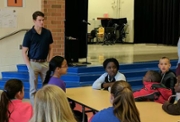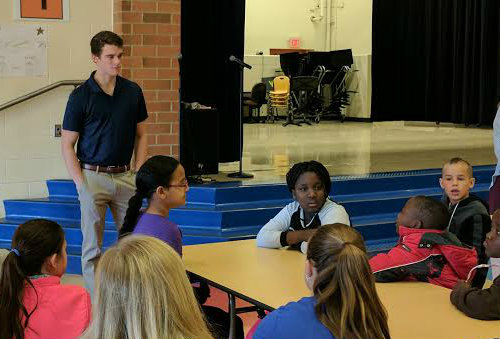Reframe Podcast: Episode 3

Managing Evolving Teacher Environments

Today, breaking down barriers that can impede professional or cultural progress is becoming a key goal for many progressive organizations. Embracing opportunities to do so can not only open the door to a multitude of illuminating new perspectives, they can also become a bridge to cross-collaborative partnerships that are crucial for success in so many ways.
James Loy:
This is Reframe, The podcast from the College of Education, Health and Society on the campus of Miami university.
Over the last few years, classroom dynamics have fundamentally changed, and so has the face of a diversified student population that, in many ways, may respond better to educational approaches that are very different from those that have been used in the past
So today we are talking to Dr. Michelle Cosmah, a Clinical Faculty Member in the Department of Teacher Education, about how teachers can hope to succeed in such a rapidly evolving environment.
So Dr. Cosmah, can we talk a bit about how your work helps to advance the EHS vision, which is to be an innovative leader transforming the lives of those it serves through a holistic approach that reflects a changing global society?
Dr. Michelle Cosmah:
So I would say that creating leaders among teachers is very, very important in what I do. So for a lot of this, we have to change the way education is being taught in higher Ed and in PK-12 schools. And I think that my role in what I have been doing in my classes is allowing teachers not only to see the changes that need to be made, but giving them specific tools and resources that allow them to make those changes.
Too often we say, “Find things that need to be changed.” Or, “Be a change agent.” Or, “Lead the charge when you see something that is not going well.” But we don’t always tell them how to do that. So I think that the “how” is the piece that I have been focused on when I am interacting with my students.
James Loy:
So what do you think are some of the biggest challenges facing teachers and/or educational leaders? And how do you think these challenges could possibly be overcome?
Dr. Michelle Cosmah:
We have such a different . . . the population in our public schools continues to change. And I think it is my job to allow teachers opportunities to see different teaching styles, different learning styles, different cultures and different backgrounds to understanding how they can address the needs of the students that they may have, and more importantly the students that they will have, those that we haven’t even considered.
James Loy:
Sure. Well one of the things that I have always wondered and thought about . . . It seems like a couple of generations ago students could have learned directly from the experience of their parents and their teachers from that era, and their grandparents even. But now it seems like, for example, just my experience being in my mid 30s, my experience is no longer relevant or relatable to a college student, let alone a high school student, and certainly not an elementary student. So how can teachers ever hope to possibly even keep up with the pace of change, and then stay relevant to new and younger students?
Dr. Michelle Cosmah:
I think that we have to continue our professional growth, especially in higher Ed, to understand that we can’t just stay in the silo of our department or in our specialty in our research. We have to continue to learn about others and about how they are learning. One example is that I talked about the Faculty Learning Community that I was with, with agile. I am actually co-facilitating a faculty learning community this year, and it is all about millennials and generation Z, and we are focusing on how different perspectives in different generations have changed and are continuing to change. And it is exactly what you said, we talk about baby boomers, and there was a huge amount of years where people were considered baby boomers. But then you start getting into millennials and gen Z and it is changing every 10 years or something. It is drastically changing the perspective and what students are experiencing is changing.
So we have to continue to remember that, as educators, we can’t keep doing the same thing over and over. We need to reach out. We need to start compromising . . . that’s a bad word, but compromising with our students in a sense of “I want to teach you ‘this’ and I know you need to learn it ‘this’ way, or you like to learn it ‘that’ way and let’s meet in the middle.”
Instead of the typical, “Nope, we’ve always done a lecture so this is what we are going to do.” We can’t do that any more.
James Loy:
That does seem to be a big focus, right? People are trying to get away from a classical system that does not seem to be as effective anymore
Dr. Michelle Cosmah:
Correct.
James Loy:
But what else is next? How else do you hope that this discipline will evolve or what do you think is ahead for educational leaders and teachers?
Dr. Michelle Cosmah:
I think we need to become more student centered. And that doesn’t mean giving students everything that they want. But to consider themselves as learners and to challenge them with the way that they want to think. I think that that has been a problem and it kind of goes back to the “this is the way I learned, this is the way I was taught, this is the classical method” just like I was saying before. But we do have a different group of students at all of the different age levels and I don’t think we are addressing that.
So to be more student centered and to continue with our professional growth will help with the diversity of the groups that are coming in.
James Loy:
And to quickly follow up with that. What does it mean to become more student centric? What is the opposite, or what is it today? Is it more teacher centric?
Dr. Michelle Cosmah:
Yes. And would say with the push in assessments and the push in standards in PK-12, you are constantly driving everything based on the state or national initiatives and things like that. So we need to do that, but we also need to remember that there are real people on the other end and we need to focus the learning on those individual students.
I have been in many schools and even at the university level where the students become a number. It is, “Oh, we have five students who are below level. Let’s put them in the A group and they are going to be ‘here.’” But they have names and there is a reason that they are there, and we need to dig into that reason instead of just saying, “They scored ‘this’ on the test, they are a 49, we need them to be a 50.” We need to consider the more holistic approach, I guess, would be a better way.

